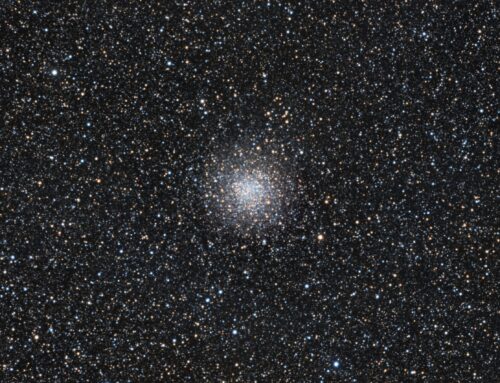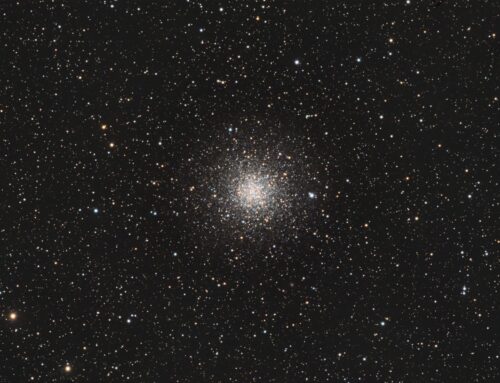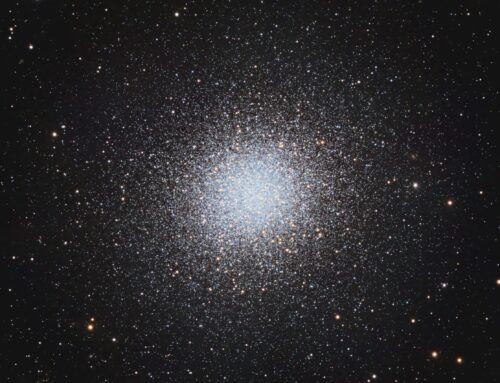Tekkies:
SBIG STL-11000M camera, Baader LRGB filters, 10″ f/6.8 ASA astrograph, MI-250 mount. Guided with external SBIG guider and 500mm f.l. guide scope. Acquisition and using Maxim-DL. Focused with FocusMax. Shot from my SkyShed in Guelph, Ontario. No moon, average transparency and seeing. Calibration in MaximDL. Registration, integration and processing in PixInsight. Data was acquired in May 2012 and re-processed in 2016.
6x5m R, 8x5m G, 8x5m B, 6x10m L and 10x5m L (total 3hr40m)
RGB
Creation and cleanup: The BatchPreprocessing script was used to create R, G and B masters. These were combined with ChannelCombination, and the resulting RGB image was cropped and processed with DBE, followed by ColorCalibration.
Linear Noise Reduction: MultiscaleLinearTransform was used to reduce noise in the background areas of the RGB image. Layer settings for threshold and strength: Layer 1: 3.0, 0.5 Layer 2: 2.0, 0.39 Layer 3: 1.0, 0.25 Layer 4: 0.5, 0.1. A mask was used to protect high signal areas.
Stretching: HistogramTransformation was applied to make a pleasing yet bright RGB image. Colour saturation of stars and M13 were increased using a mask to protect the background.
Synthetic Luminance
Two separate luminance frames were made from the 5m and 10m luminance subs. Each was processed with Dynamic Background Extraction. They were then aligned to each other and combined using HDRCombine.
Creation and cleanup: The cropped R,G, B and HDR Luminance masters were combined using ImageIntegration tool (average, additive with scaling, noise evaluation, iterative K-sigma / biweight midvariance, no pixel rejection) to create the SynthL channel. DBE was applied.
Deconvolution: A copy of SynthL was stretched to use as a deconvolution mask. A star mask was made from unstretched SynthL to use as a local deringing support. Deconvolution was applied (100 iterations, regularized Richardson-Lucy, external PSF made using DynamicPSF tool with about 20 stars; local deringing at 70% and global dark deringing at 0.03).
Linear Noise Reduction: MultiscaleLinearTransform was applied to reduce the noise. Layer settings for threshold and strength: Layer 1: 3.0, 0.6 Layer 2: 2.0, 0.5 Layer 3: 1.0, 0.4 Layer 4: 0.5, 0.15
Stretching: HistogramTransformation was applied to make an image with similar brightness to the RGB image. TGV Noise was applied using a mask to protect high-signal areas and the image was re-stretched to reset the black point.
Combining SynthL with RGB:
The luminance channel of the RGB image was extracted, processed and then added back into the RGB image as follows:
1. Extract luminance from the RGB image.
2. Apply LinearFit using SynthL as the reference.
3. Use ChannelCombination in Lab mode to replace the RGB’s luminance with the fitted luminance from step 2.
4. LRGBCombine was then used to make a SynthLRGB image.
Final Processing
HDRMultiscaleTransform was applied at a setting of 6, followed by LocalHistogramEqualization (scale 100,max contrast 1.5, strength 0.5). The results was blended back into the original 50:50. Overall contrast and brightness and saturation were increased slightly with the Curves tool.
Image scale is about 1.1 arcsec per pixel for this camera / telescope combination.






Leave A Comment